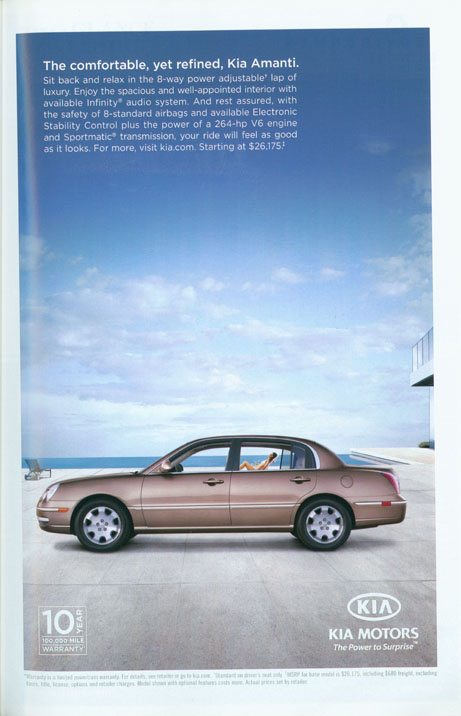“Capitalist Nature: Production and Modernity” – regular-speak layman’s definition forthcoming
- “linear perspective”
- “realist painting (freezing place from a particular point of view and locating the viewer outside of the picture and thus outside of nature and history)”
- “objectification of landscape as vista with a concomitant politics of vision-a scopic regime”
- “initiation of surveillance and monitoring on a large scale (Foucault’s [1979] panopticism)”
- “totalizing male gaze which objectifies landscape and women in particular ways”
- as in landscape art, nature takes on “a passive role deprived of agency under a totalizing perspective that create[s] the impression of unity”
Escobar, Arturo (1999). After Nature: Steps to an anti-essentialist political ecology [and comments and replies]. Current Anthropology, 40, 1-30

Myths of Nature in post-WWII National Geographic Car Advertisements by Shwandel N. Fraser is licensed under a Creative Commons Attribution-Noncommercial-No Derivative Works 3.0 United States License.
Categories: Uncategorized
Tagged: Capitalist Nature

National Georgraphic August 2007
This ad seems to portray what Escobar terms Capitalist Nature. The expansive vista of the sky frames the KIA Amanti which in turn, through its rear window, frames the sunbather. This ad is composed with a linear perspective focused on the aforementioned elements, as well the angular, modern [read: strictly geometric] and stark white design of the house. As the viewer, we are outside of this luxurious moment in this exclusive location. Its exclusivity is communicated by the expansive backdrop of the uninterrupted view of the sky, and the privateinfnity edge swimming poolnext to which the model relaxes. The image communicates that this type of relaxation in such a setting is the only way to enjoy the sky and blue waters. The car itself is parked near the pool on pristine white tiles, certainly not where one would expect a car to be, tellign us that the “well-appointed” yet relatively affordable KIA Amanti can be the regular person’s means to enjoying an attainable version of the ‘good life’.
The sunbather is completely anonymous in that we cannot discern any of her features, but we know that she is a woman becuase she is relaxes under the sun that we cannot see, wearing a white swimsuit. She is just a small part ofthe landscape, the only curves aside from those of the car and the coud formations. She is completely objectified as decoration for the car, as much as the skyscape is objectified to highlight the car. Add to that the fact that she is shown through the back window, doubly a reference to raer leg room for seated passengers, however the combination of her near nudity and recline dposition also obliquely refers to other [innuendo] backseat possibilities.
So we must ask, what is missing?
1) The person who sits inteh other beach chair, presumably the Man through whose eyes we may be looking. His view of his home, his car, his woman and private view.
2) Water fowl for starters. Land other than the tiled ground on which the car rests. This location is completely anonymous, unknown and unknowable beyond the implications of rarified air that most people who purchase a $26k car will never, ever know.
What is this ad communicating? About Nature?
This car is the way to appear wealthier and more refined to onlookers. Nature is nothing more than background colors and textures that can enhance the beauty of man made creature comforts, it is not spectacle in itself, only adornment for material possessions.

Myths of Nature in post-WWII National Geographic Car Advertisements by Shwandel N. Fraser is licensed under a Creative Commons Attribution-Noncommercial-No Derivative Works 3.0 United States License.
Categories: tourist nature
Tagged: ahistorical landscape, Capitalist Nature, cars, consumer culture, feminist critique, male gaze, romantic, technology conquering nature
“Organic Nature: Culture and Local Knowledge” – regular-speak layman’s definition forthcoming.
Arturo Escobar brilliantly questions the relationship between local constructions of nature and our “present-day concerns, particularly sustainability, and whether there are notions akin to management or control in native representations and local models of nature”
He lists the characteristics of what he calls Organic Nature (which may or may not coincide with ideas contained within Capitalist Nature).
- Lack of “nature-society” dichotomy; “a complex image of social life that is not necessarily opposed to nature (in other words, one in which the natural world is integral to the social world)”
- “the entire universe is conceived as a living being with no strict separation between humans and nature, individual and community, community and the gods (Grillo, 1991, Apffel-Marglin and Valladolid 1999)”
- “Local models [of nature] may also evidence a particular attachment to a territory conceived as a multidimensional entity that results from many types of practices and relations”
- Specific categorizations of human, social, and biological entities (for instance, of what is human and what is not, what is planted and what is not, the domestic and the wild,m what is innate and what emerges from human action, etc.), boundary settings and systematic classifications of animals, spirits, and plants.
- “It may contain “mechanisms for maintaining good order and balance in the biophysical, human and spiritual circuits (Descola, 1992, 1994)”
- “…or a circular view of biological and socioeconomic life ultimately grounded in Providence, gods, or goddesses (Gudeman and Rivera 1990)”
Escobar, Arturo (1999). After Nature: Steps to an anti-essentialist political ecology [and comments and replies]. Current Anthropology, 40, 1-30

Myths of Nature in post-WWII National Geographic Car Advertisements by Shwandel N. Fraser is licensed under a Creative Commons Attribution-Noncommercial-No Derivative Works 3.0 United States License.
Categories: Uncategorized
Tagged: Organic nature


